Dr Vino's wine blog
wine talk that goes down easy
Wine ethanol, lightest bottle, oxygen, supermarket brands – sipped and spit
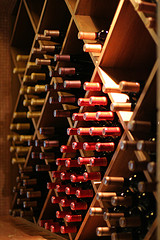 SIPPED: waste wine
SIPPED: waste wine
A new company is turning waste wine (and beer) into ethanol. Marquee investor: Shaq. [LA Times]
SPIT: bodybuilders
A new, lightweight (300g) glass bottle will debut in the UK next year. [Decanter]
SIPPED: “indelible stain”
Michael Broadbent’s lawsuit against Random House, publisher of the The Bilionaire’s Vinegar, only serves to draw attention to the “indelible stain on his record” that the Rodenstock/Jefferson bottles represent. [Slate]
SIPPED: wine geekdom
Jamie Goode explores the love-hate relationship between oxygen and wine, corks and screwcaps. [Wines & Vines]
SIPPED: public sector frugality
A general in the British Army made the news for £1.49 supermarket Merlot for his guests–among other cost saving measures. No moat cleaning for him! [Timesonline.co.uk]
SIPPED: private label brands
“A $3 unknown wine at Safeway makes you think ‘how can it be any good?’ while a $3 wine with the Trader Joe’s imprimatur makes you think ‘how bad can it be?'” [Wine Economist]
SPIT: pricing information
A pet peeve: winery and wine store web sites that don’t make it easy to tell the price and/or legal possibility of shipping without doing an arduous check-out or profile procedure.
Australian Riesling – Can it age? – Grosset, Steingarten and Leo Buring
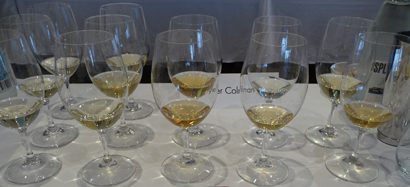
One question that led me to Australia is whether Australian Riesling can age. The wine is almost always released within a year of harvest so the tendency is to drink it young when it can be very refreshing. Riesling from Australia tends to be dry and is almost always bottled under screwcap now.
The youngest Riesling I’ve tasted was a tank sample of the 2009 Jacob’s Creek Steingarten Riesling. The Steingarten vineyard was originally about 1000 vines planted in the 1960s at the top of Trial Hill, a windy spot on the edge of the Eden Valley. At the outset, it was a single vineyard wine of tiny production. But now although most of the vines come from an altitude of 500 meters, it makes no claim to be site specific; the Steingarten name is a brand. The tank sample was brimming with citrus intensity but not yet really formed as a wine. The 2005, by contrast, was in a very nice spot, exhibiting more muted lime and floral character. The 1998 was oddly phenolic and, while quite solid, not as rewarding today as the 2005. Read more…
Hitler, translation, corks, France, ID – sipped and spit
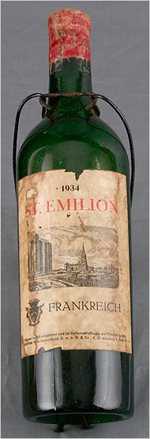 SIPPED: Stalinist architecture in St. Emilion!
SIPPED: Stalinist architecture in St. Emilion!
A bottle of wine allegedly in Hitler’s cellar at the Berghof sold for $900 at Alexander Autographs recently. The label might have raised some questions since has only St. Emilion, Frankreich (German for France) emblazoned on the front with no producer name, a vintage of 1934, and what a blog at the NY Times describes as a “Stalinist-style structure towering over the church.” Donald and Petie Kladstrup, co-authors of Wine and War: The French, the Nazis, and the Battle for France’s Greatest Treasure, told the NYT blog that Hitler “occasionally drank wine, though he preferred beer.” What ever happened to his being a teetotaler?
SPIT: translation
A lot of wine descriptors could be interpreted as bedroom talk. But Jim Boyce writes about a case worthy of Engrish.com, a Chinese back label that cuts to the chase: “Yellow flowers and a beautiful apricot color with a strong musk. Rich texture with sweet f*ck in sweet orange peel and apricot flavor at the end of a clean. Drink now.”
SPIT: Champagne corks
Champagne, perhaps the last regional holdout (ex-Portugal) from the assault of screwcaps, now has The Maestro. Although we mentioned it previously, details are now out: The new closure, which hides a crown cap (think: beer) under a plastic cover and lever, will soon adorn select bottles of Duval-Leroy champagne. TIME says that it is “far easier to use than a conventional stopper— no struggling to hold the heavy bottle as you twist, no worrying that you’ll take someone’s eye out with the cork.” But, really, a lever doesn’t add to the bottle’s aesthetics–get a grip! [see video of the Maestro in action]
SPIT: wine
In France, consumption continues to fall. So do exports. “French households drank almost 10 percent less wine last year than in 2007, and exports by French vintners sank 15 percent by volume and almost 30 percent by value in the first quarter of 2009, the agriculture ministry reported.” [AP]
SIPPED: ID
Equifax, a credit rating agency, is developing a service to strengthen online identities, which could be particularly useful to verifying the age of someone who wants to buy wine on the web. [Bits blog]
Photo: Alexander Autographs
Oxidative wines – vin jaune – Domaine Berthet-Bondet, Jura
Oxidative wines are an essential wine tasting reference point. Too much oxygen during winemaking (or bottle aging) and a wine becomes oxidized, a flaw; just enough and it is oxidative, a sort of nutty character that people generally love or hate. In my multi-week wine classes, I always try to pour one, usually a sherry, just to provide the distinctive tasting experience. Since we’ve been talking about reductive wines and screw caps recently, the other side of the coin (barrel?) should receive a little love here too. And why not a vin jaune from the Jura?
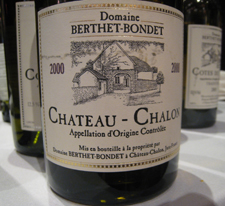 Located about half way between Dijon and Geneva, the pocket-sized region of the Jura makes some of France’s most distinctive wines. At a recent trade tasting, I sampled a few of the wines from Domaine Berthet-Bondet, a winery founded by Jean Berthet Bondet on the relatively New World time frame of 1985. The Cotes de Jura Chardonnay 2006 is matured in neutral oak barrels and has a vein of minerality so rich it would out Chablis out of business if the world craved minerally chardonnay.
Located about half way between Dijon and Geneva, the pocket-sized region of the Jura makes some of France’s most distinctive wines. At a recent trade tasting, I sampled a few of the wines from Domaine Berthet-Bondet, a winery founded by Jean Berthet Bondet on the relatively New World time frame of 1985. The Cotes de Jura Chardonnay 2006 is matured in neutral oak barrels and has a vein of minerality so rich it would out Chablis out of business if the world craved minerally chardonnay.
But the piece de resistance was the 2000 vin jaune (a type of “vin de voile” ) from the micro-appellation of Chateau-Chalon. Made entirely from the Savignan grape, the wine is matured for six or seven years in small neutral barrels, which are intentionally not filled all the way nor replenished (as barrels usually are to replace the “angels’ share” that evaporates). This creates further exchange with oxygen. But a film of beneficial yeast forms on the surface to moderate the oxygen exchange and prevent it from heading on a crash course to becoming vinegar. The aging happens in a well-ventilated room so there are wide temperature fluctuations through out the long aging. A complex wine emerges from the process, with aromas of walnuts, dried apricots, daisies. The nutty finish lingers for hours. Really. Truly a wine of contemplation. The oxidative process girds the wine for decades or centuries in the cellar.
Unfortunately, the wine sells for north of $100 for a 62cl bottle (find this wine). Their Cotes de Jura Tradtion 2003 provides the oxidative wine character, but at a fraction of the price (about $22; find this wine). I’d try both with Comté cheese.
Now if only we could come up with a sexier term than “oxidative”!
Randall Grahm – the way back is the way forward – part II
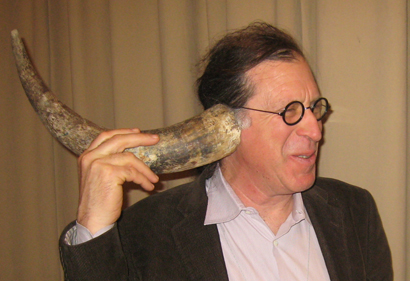
Randall Grahm is one of America’s most fascinating winemakers and winery owners. From his base in Santa Cruz, he rose to fame (and a good bit of fortune) by following the path of grape varieties traditionally from the Rhone and Italy–with a dose of Zinfandel. Puns and cute labels helped make the wines fun and approachable. Consider that in 1992 he bought a vineyard in Soledad, a town then best known for a large prison, and decided to call the resulting wine “Big House Red” complete with a cartoon jailbreak on the front. Or Cardinal Zin, a Zinfandel with a Ralph Steadman depiction of a cardinal on the label.
But Grahm has had a change of heart. A thorough profile in Inc magazine last summer indicated that, in close succession, he became a dad and had health problems that led to what they call a “do over.” He sold off Big House and Cardinal Zin to The Wine Group two years ago. He ramped up his appreciation of Biodynamics, an organic approach to vineyard management that blends in a dose of the celestial. He toned down the humor on his labels and has added graphic depictions of crystal formations that map the terroir of a vineyard on the Ca del Solo labels.
He’s also experimenting more with winemaking. Many wines are matured in small oak barrels that are new. Grahm is using slightly larger casks, called puncheons, that are old. The older and bigger barrels slow the exchange with oxygen, which can make the resulting wines more age worthy and can express the grape and the place more clearly without so much barrel influence. But his biggest experiment is with his 2008 wine called Le Cigare Volant, a blend of Grenache, Mourvedre and Syrah. He has held some of this wine to mature after fermentation in a series of large bottles known as demi-johns that allow virtually no exchange with oxygen.
I caught up with him at the recent tasting of his NYC distributor, Michael Skurnik. We talk about screwcaps, the wave of the future, and…England.
Nearly seven years ago, you held a ceremonial funeral for the cork and started bottling all Bonny Doon wines under screwcap. Did you replace one problem, TCA tainted corks, with another, reduction [which can lead to rotten-egg smell in some cases]? Read more…
Bonny Doon’s labels bare all – Randall Grahm, part I
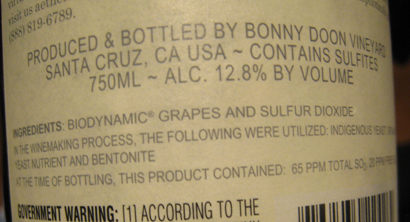
Spotted yesterday at a trade tasting: Bonny Doon’s labels are now baring all and putting a full “ingredient” list. This is not a legal requirement but more comprehensive labeling for wine is a subject that is in play. While more information on labels is a probably good thing, it would be helpful to have some context about some of lesser-known aspects of winemaking. But maybe that’s what the internet is for, researching things like wine ingredient lists. What do you think about more information on wine labels?
I asked Doonmaster Randall Grahm what prompted him to take this extra step. He said his reasoning was twofold. While admitting it was a little bit “pious” on his part, he said that he was doing it in part to encourage the industry to do more with less and to be more natural while “trumpeting our own virtue.” Further, he said that it is kind of an enforced discipline: “if you have to add it to the label, you think twice before doing anything.” He added, “It makes a better wine.”
Stay tuned for more with the Randall Grahm as I ask him about screwcaps and his new project!
In case you can’t read it from the blog-blurry photo of his 2008 Albarino (find this wine), here’s the text after the jump: Read more…
Pardon, Madoff, barrel motel, Saran Wrap, discussion – sipped and spit
SPIT: presidential pardon
Of all the names circulating for a presidential pardon, few lists would include Fred Franzia for his federal offense (and, no, as much as reader Alberto would like, it wasn’t making Two Buck Chuck). But Franzia wants to own a gun. That’s one thing that he can’t do because in 1993 he pleaded guilty to federal charges of conspiracy to defraud, paid a $2.5 million fine. The AP reveals how he worked the system–unsuccessfully–to try to get a presidential pardon. He’s no turkey! (via Mark Fisher)
 SIPPED: roll out the barrels
SIPPED: roll out the barrels
A hotel in Holland (of all places) allows you to fulfill one of your wine fantasies–sleeping inside an old oak barrel! Wait, that’s not one of your wine fantasies? Well, you can now do it anyway. Just don’t bring luggage because a 15,000 liter vat is not all that roomy for two humans! (Treehugger, via Mark Fisher)
SPIT: editors
Ruth Madoff may be in the news for the alleged Madoff Ponzi scheme. While the details of that are being sorted out, Karen MacNeil, a Napa-based wine and food writer, has come forward to say that she was more than an editor on Ruth Madoff’s kosher cookbook. “But in point of fact, I wrote the entire book,†MacNeil told the Times. (Thanks, Steve!)
SIPPED: pennies and Saran Wrap
Just in case you thought manipulation of wine was limited to the winery, Harold McGee gives people the discusses dunking knives and pennies in his wine–but ultimately gives people the green light to use plastic wrap to remove cork taint! Has anyone ever done this successfully? Hit the comments! [NY Times]
SPIT: discussion
Over on eBob, discussion about my recent Q&A with John Gilman was cut off after 130+ comments.
Better wine through science!
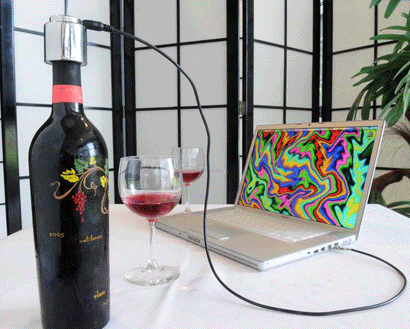
Researchers at the Argonne National Laboratory have taken a break from their usual physics research and turned their attention to combating wine fraud.
Roger Johnston and Jon Warner in Argonne ‘s Vulnerability Assessment Team have developed a cap that can be put in place at the winery to track if the bottle has ever been opened or tampered with.
However, if you thought resistance to screwcaps was high in the realm of fine wine, get a load of this Lojac meets Denver Boot meets car alarm thingy. And just look how it makes your laptop bug out when you connect the two! Full details on the story in their press release. (hat tip: Andrew)
In other wine and technology news circulating today, the e-tongue has resurfaced. But we’ve already wagged our tongues at that one!



